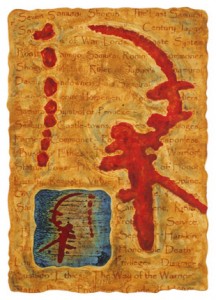From August 27 – Sept 19, 2010, one of my Arborglyph monoprints is in an international exhibit called StrassenKunst at Artspace Gallery in Richmond, VA. The theme of the exhibit is artwork INSPIRED by graffiti with 59 artworks chosen. There are photos of graffiti, paintings with graffiti images, jewelry and sculpture scratched with graffiti-like symbols, and so on.
Graffiti art isn’t just street art, nor is it always gang related. While graffiti today is often thought of as destructive and a form of vandalism, it has helped arhaeologists decipher interesting cultural practices and has brought history to a forefront.
The first graffiti art was created over 30,000 years ago at Lauscaux caves, and a few summers ago I visited that wonderful site. I have a penchant for cave art, rock art, petroglyphs, and pictograms, and those sites are inspiration for my Arborglyph monoprints. My graffiti inspiration is the from the markings on aspen tree bark in Colorado by humans, animals, or nature’s own scarring. In the American west, many trees were first engraved by the Basque and Hispanic shephards and the term Arborglyph (tree with a glyph) was born.
Apparently, the term “graffiti” came from the Italian term “graffiato” which means “scratched”. Graffiti generally means any writing on a public place, and it has been done over the centuries by the Greeks, Romans, Mayans, Vikings, and Celtics, to name a few. I was in Pompeii this summer, and the archaeologists had unearthed some interesting graffiti on walls there. In China, Mao Zedong was known for publicizing everything, including a 4000 character graffiti slogan on a wall. Throughout history man has yearned to “make a mark”.
Although their are many controversaries over some artists such as Bansky from England, graffiti has become more accepted in some fine art circles. Artists such as Keith Haring and Jean-Michael Basquiat did graffiti in subway stations and in the streets. Later they both became famous by showing in fine art galleries in the early 1980’s, and numerous videos were made of their lives and art. Interestingly, Basquiat in his early graffiti years left his “tag” SAMO in many places. The symbol I use in my art title in the StrassenKunst exhibit is SAM. I wouldn’t claim that I use “tags” in my artwork, but I do use symbols in the titles that are my own “alphabet”.
A “tag” is the most basic writing of an artist’s name, it is simply a handstyle. A graffiti writer’s tag is his or her personalized signature. Tagging is often the example given when opponents of graffiti refer to any acts of handstyle graffiti writing (it is by far the most common form of graffiti). Tags can contain subtle and sometimes cryptic messages, and might incorporate the artist’s crew initials or other letters.
Subsequently there are many graffiti INSPIRED artists and art exhibits today. I personally do not condone defacing public property with art. However, photographing graffiti art (on trees) has proven to be an interesting subject matter for me.

Leave a Reply